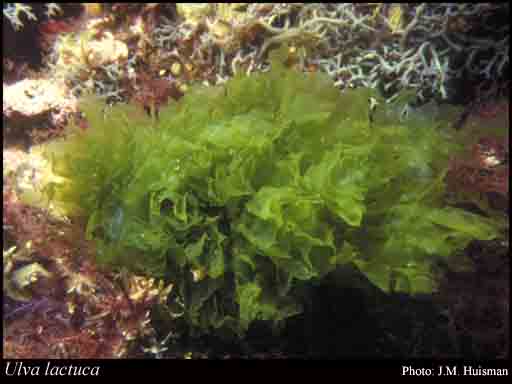- Reference
- Sp.Pl. [Linnaeus] 1163 (1753)
- Conservation Code
- Not threatened
- Naturalised Status
- Native to Western Australia
- Name Status
- Current

Scientific Description
Habit and structure. Thallus grass-green, usually with a single frond from the holdfast, entire or irregularly lobed or divided, to 15 cm long and 1–10 cm across; margin entire, surface smooth. Cells in surface view in short rows becoming more irregular below, isodiametric to slightly elongate, (10–)12–18(–20) µm across or long above, 20–25 µm long below; pyrenoids 1–2(–3) per cell. Thallus 40–60 µm thick in upper parts with cells in sectional view rather square to rectangular, L/B 1.0–1.4 and 18–22 µm long; 60–85 µm thick in mid and lower parts with cells in section L/B 1–1.2(–1.4) and 22–26 µm long, becoming 75–100(–250) µm thick near the base with a narrow to moderately broad central mass of rhizoids.
Reproduction. Generations isomorphic, the sporophyte producing quadriflagellate zoo(meio)spores, and the gametophytes unisexual with biflagellate anisogametes which can germinate directly to form the gametophyte again.
Distribution. Recorded from several locations in W. Aust. In southern Australia, known from Christies Beach and St Kilda, S. Aust. and Port Phillip, Vic.
[After Womersley, Mar. Benthic Fl. Southern Australia I: 141 (1984)]
Distribution
- IBRA Regions
- Carnarvon, Jarrah Forest, Swan Coastal Plain.
- IBRA Subregions
- Cape Range, Perth, Southern Jarrah Forest.
- IMCRA Regions
- Abrolhos Islands, Central West Coast, Leeuwin-Naturaliste, Pilbara (offshore), Shark Bay, WA South Coast.
- Local Government Areas (LGAs)
- Albany, Ashburton, Cockburn, Cottesloe, Fremantle, Greater Geraldton, Irwin, Joondalup, Karratha, Mosman Park, Nedlands, Peppermint Grove, Perth, Port Hedland, Rockingham, Shark Bay, South Perth, Subiaco, Wanneroo.